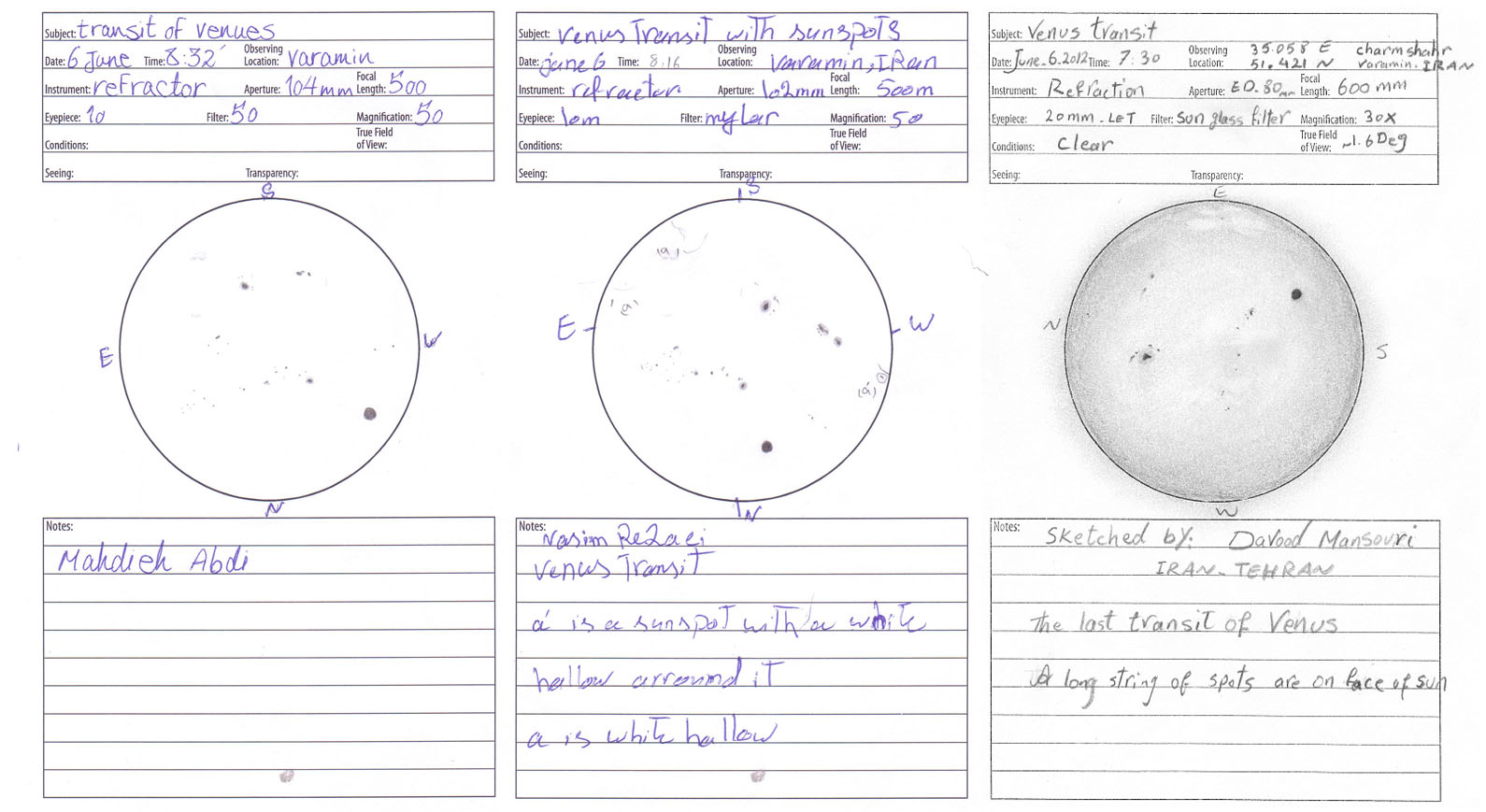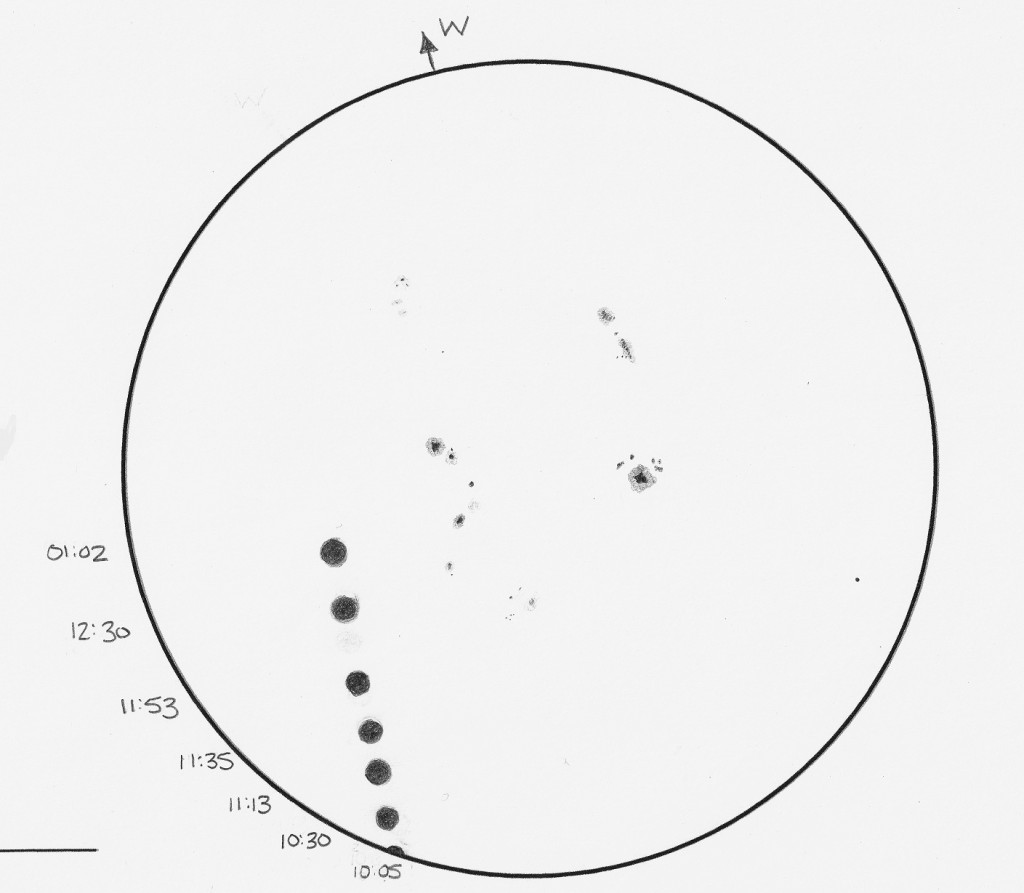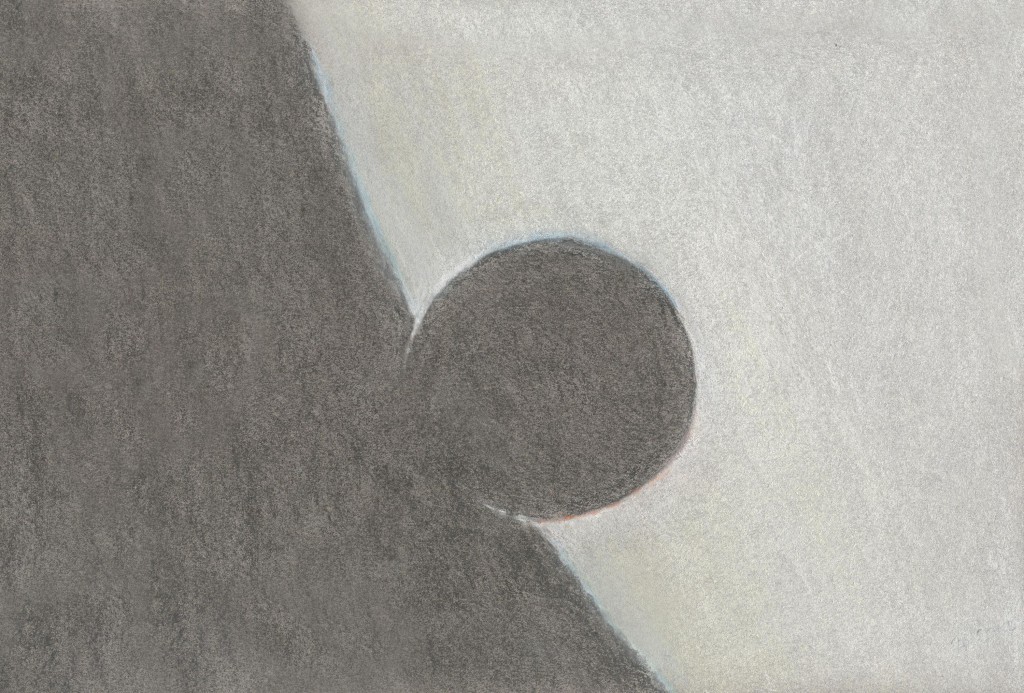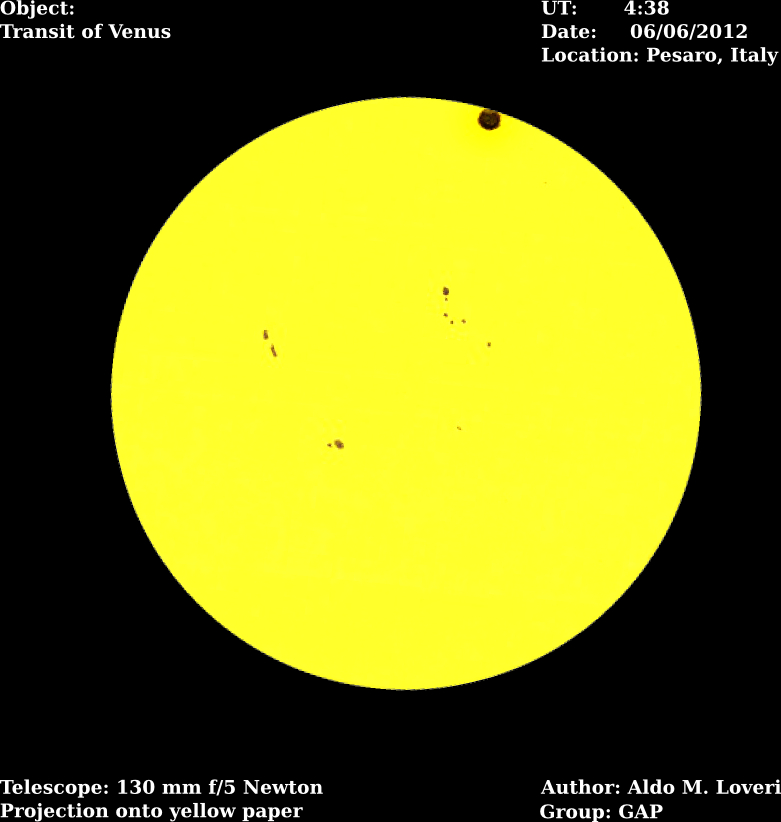
Drawn by: Davood Mansoori, Nasim Rezaei, Mahdieh Abdi

Object Name – Sun and Venus
Object Type – Solar System
Location – Green Bay, WI
Date – 6/5/2012
Media – graphite pencil, white paper.
I would like to submit this sketch of the transit of Venus. The sketch was made with my 10” Discovery Dobsonion telescope at about 80 x using a Mylar solar filter. I first sketched the Sun and sunspots before the transit began and then added Venus at various intervals as the transit progressed. The numbers along the side are the times the silhouette of Venus was added, in UTC. I was only able to see about half of the transit from Green Bay. The astronomy club I belong to, the Neville Public Museum Astronomical Society, hosted a public observing event. We had a very large turnout and the weather was great. It was a very enjoyable day and I was happy to capture it in this sketch.
Thank you,
Brian Chopp

After having travelled more than 400 kilometers from the Netherlands to a location at the Baltic sea in Germany, I gathered with a group of eight other amateur-astronomers to witness the Venus transit. From europe, we could only see the last two hours. But because of that we saw the most spectacular sunrise ever.
The sketch is made a few minutes after the start of the egress and it shows the aureole phenomene, which was hard to see due to some high cirrus clouds.
But at moments of better seeing, the thin line of the atmosphere of Venus was clearly seen.
The instrument was a 20 cm Newtonian @ 135x. Exact time of the sketch was 5h43’ UT.
Greetings,
Tom Borger
The Netherlands.

Object: Transit of Venus
Location: Pesaro, Italy
Date: 06/06/2012
Pencil on yellow paper, colour and contrast correction with Gimp
The sky was very clean, we coud even see Croatia’s mountains on the other side of coast. Venus was already there at about three quarters of her journey across the solar disc. I used a 32 mm plossl eyepiece to project the Sun on a yellow sheet of paper and marked the sunspots and Venus with a pencil. This drawing pictures the third contact.
Aldo
Hey Artists!
It is now One year left to the last transit of Venus across the sun for this time!
It happens on the “wrong side” of the earth for us in Norway, but in northern Norway
we can see it low over horizon in the night (midnightsun).
I enjoyed the transit in 2004 in Greece. Info on my sketch! I used crayons and pencil.
Best wishes for this on “the other side”!!
Per-Jonny Bremseth.
Jupiter moon Europa has just transited Ganymede, November 17, 2009
Sketch and Details by Michael Rosolina
Because of the geometry of Earth’s orbit in relation to Jupiter’s orbit, this has been a very good year for seeing transits across the Jovian disk. Not only have there been numerous transits of the Galilean moons and their shadows, the moons themselves have been transiting and occulting one another as seen from our vantage point here on Earth.
In this sketch, Europa has just completed an annular transit of Ganymede, passing in front of the larger moon but not blocking it completely. Because of Jupiter’s low altitude, I was unable to use high enough magnification to see any detail of the transit beyond watching the two bright dots move towards each other, merge, and then move apart.
At the same time, Callisto (the largest Galilean moon) was transiting in front of Jupiter. Unlike the two smaller moons, Io and Europa, which tend to disappear from view after they cross the Jovian limb, Callisto (and Ganymede) usually can be seen against the cloudtops due to their darker albedo. [All of the moons’ shadows can be seen in transit given adequate seeing conditions.]
This sketch of Jupiter was done at the eyepiece using 2B and 4B graphite pencils on white copy paper. After scanning, I set Jupiter against a black digital background, placed the positions of the satellites from field notes, and added the text.
I hope you enjoy this view of the King and his consorts and get a chance to see one of these transits yourself before the giant planet disappears for the year.
Jupiter and Galilean Moons
Planet
Friars Hill, WV USA
17 November 2009
Clear skies,
Michael Rosolina
Mercury-Solar Transit
Sketch and Commentary by Jeremy Perez
Move cursor over sketch to see labels.
On Wednesday, November 8th, 2006, Mercury was due for a solar transit. Now, in my neck of the woods, that just happens to be a work day. So I planned to set up the scope during lunch in the parking lot, or outside the lunchroom. The only thing I needed was a solar filter. A couple years ago, a very kind and generous amateur astronomer from Phoenix, Scott Kroeppler, sent me a couple small Baader solar film samples. Other than some casual, unmagnified looks at the sun, I hadn’t put them to good use. Until now. I stayed up the night before, rigging these two 1-inch square pieces of solar film and a sewing hoop to an 8 inch square piece of foam core. I wasn’t sure if it would work, but the next morning, I pulled into the parking lot at work, put my mangy, home-made solar cap on the front, and got a handheld look at the sun for the first time through my own scope. Not only did it work great, but I was pleasantly surprised to see a huge sun spot easing over the solar limb.
So I got to work, and then about 15 minutes before the beginning of the transit, I put it all together on the patio outside the lunch room where I had the best opening between all the trees. I didn’t start quite early enough, because by the time I got everything set up and the solar cap taped on securely, Mercury was already well inside the solar disc. It looked just like a printed period against blue-white filtered circle of the sun. It had entered just south of the massive sunspot I noticed earlier. A couple fainter sunspots rested on the opposite side. At that point, I made my first solar sketch, and noted how easy it would be to really exaggerate distances and proportions across the sun’s face. I was excited to see that light, textured, filamentary features were visible around the sunspots. As I studied these features, I noticed that it didn’t take long for Mercury’s motion to become apparent.
Over the next 45 minutes, I invited passing coworkers to have a look. They all seemed happy to get a look at the transit, particularly after reading about it in the newspaper the day before. As folks walked up to the eyepiece, I tried to coach them a bit with the sketch to be sure they didn’t confuse the sunspot for Mercury. Quite a few commented on how very tiny the little planet appeared. Several of them were even able to make out the two relatively faint sunspots over on the western limb as well. After a little more than an hour, I moved the scope to an out-of-the-way spot, and went back to work.
At about 20 minutes before the end of the transit, I raced outside to find that the sun was completely hidden behind trees where I had the scope set up. With a bit of scouting, I moved the whole thing into the parking lot about a hundred yards to the north where I had a clear vantage. And here I got to watch that perfect little dot edge closer to the western edge of the sun. At about four Mercury diameters from the edge, the whole shebang began to sink behind a tree-lined ridge a mile to the west. So I missed seeing Mercury merge with and disappear into the darkness on the other side of the sun. It was still a fascinating event to witness, and since Mercury won’t do this again until 2016, I’m glad I was able to fit it in.
The sketch at the top of this post was overlayed onto a digitally generated disc with limb darkening that estimates what I saw through the eyepiece. The next time I sketch the sun this way, I’m sure I’ll want to include the lighter features, which will mean generating that limb darkening manually and erasing through it.
| Subject | Mercury – Solar Transit |
| Classification | Planetary/Solar |
| Date/Time | November 8, 2006, 12:33 – 04:54 PM MST (November 8, 2006, 07:33 – 11:54 UT) |
| Observing Loc. | Flagstaff, AZ |
| Instrument | Orion SVP 6LT Reflector (150 mm dia./1200 mm F/L) |
| Eyepieces/Mag. | 25 mm (48X) |
| Conditions | Clear, breezy |
| Seeing | Ant. IV |
The transit of Venus June 4th, 2007
By Michael Rosolina
While listening to the McDonald Observatory’s StarDate, I was surprised to hear that
this week marks the 125th anniversary of the 1882 transit of Venus. In my mind I
was transported back to June, 2004 eagerly anticipating the first Venus transit
since 1882. No one living at that time had ever seen such an event.
The transit would be nearing its end when the Sun rose at my location so I set up my
small, portable Astroscan telescope equipped with a homemade white light filter on
the mountaintop behind my home. I wanted my wife to see this rare event too, so I
lured her out by saying I needed her to watch my back for bears (not entirely
untrue–it was mating season and the black bears were very active).
As the Sun rose, we were completely enveloped in a cloud but soon the mist thinned
and we could see the small black dot against the solar disk with the unaided eye.
As conditions improved, we employed filters on the scope and on a pair of 10×50
binoculars to track the progress of Venus towards the Sun’s limb.
During egress, I was fortunate to detect the aureole created by the planet’s
atmosphere. This halo was first seen during the 1761 transit by Russian scientist
Mikhail Lomonosov, who rightly concluded that Venus had an atmosphere. The egress
created some interesting contrast effects which I have tried to render as I saw
them.
I later discovered that there was indeed a small sunspot group near the Sun’s
central meridian, but I could not see it because of the poor transparency.
The sketch was done in the field with 2B and HB graphite pencils on Strathmore
paper. I used a 4 inch template for the Sun and a penny to make the template for
the inset.
Seeing the transit was a peak experience for me (my wife was glued to the binoculars
through the whole thing, too). It was also very gratifying to see how the event
brought the global amateur astronomy community together as we shared sketches and
images via the Internet.
The next Transit of Venus will be June 6th, 2012. Clear skies to all in 2012–there
won’t be another transit for over a hundred years.